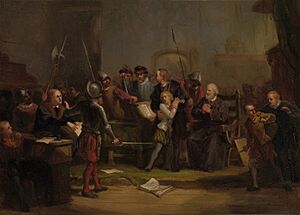Philip William, Prince of Orange facts for kids
Quick facts for kids Philip William |
|
|---|---|

Portrait by Frans Pourbus the Younger, 1600
|
|
| Prince of Orange | |
| Reign | 10 July 1584 – 20 February 1618 |
| Predecessor | William I |
| Successor | Maurice |
| Born | 19 December 1554 Buren, Gelderland, Seventeen Provinces |
| Died | 20 February 1618 (aged 63) Brussels, Spanish Netherlands |
| Burial | Diest, Belgium |
| Spouse | Éléonore de Bourbon |
| House | Orange-Nassau |
| Father | William the Silent |
| Mother | Anna van Egmont |
| Religion | Roman Catholic |

Philip William, Prince of Orange (born December 19, 1554, in Buren, Gelderland – died February 20, 1618) was an important figure in European history. He was the oldest son of William the Silent, a famous leader, and his first wife, Anna van Egmont. Philip William became the Prince of Orange in 1584. He was also made a Knight of the Golden Fleece in 1599, which was a very high honor.
Contents
Who Was Philip William?
Philip William, known as Filips Willem in Dutch, was born on December 19, 1554. His birthplace was Buren, in a region called Guelders, which was part of the Seventeen Provinces. He was the first son of William the Silent and Anna van Egmont.
Why Was Philip William Taken to Spain?
When Philip William was 13, his father, William the Silent, was in a disagreement with the Spanish ruler, Duke of Alva. William refused to return to Brussels from Germany. Because of this, Philip William, who was studying at the University in Leuven, was taken by force in February 1568. He was sent to Spain. This happened partly to make sure his father would cooperate. Also, the Spanish wanted to raise Philip William as a loyal subject and a good Catholic.
He never saw his father again after this. His mother had passed away ten years earlier.
His Life and Studies in Spain
In Spain, Philip William continued his education at the university of Alcalá de Henares. He lived in Spain until 1596. After that, he returned to the southern part of the Netherlands, which was controlled by Spain.
Returning to the Netherlands
When Philip William returned, his sister, Maria of Nassau, strongly defended his rights. She helped him against his half-brother, Maurice of Nassau. Maurice was trying to claim the city and area of Breda, which Philip William believed was his.
In 1606, Philip William was officially recognized as the Lord of Breda and Steenbergen. He was also given the right to choose local officials, called magistrates. He had to promise to support the "Union and the Republic's religion."
In July 1610, he made a special entry into Breda. From then until he died, he regularly appointed the magistrates in his territory. Even though he brought back Catholic church services in Breda Castle, he did not try to change the main religion in the city, which was Protestant-Calvinist.
He did have a disagreement with the States-General in 1613. They canceled his choice for a Catholic official. He also had to work with the military governor in Breda, his half-brother Justinus van Nassau, who was very loyal to the States-General.
Marriage and Family Life
In 1606, Philip William married Eleonora of Bourbon-Condé in Fontainebleau. She was the daughter of Henry I, Prince de Condé. She was also a cousin of King Henry IV of France. However, Philip William and Eleonora did not have any children.
Philip William's Death
Philip William passed away on February 20, 1618. Because he had no children, his half-brother, Maurice of Nassau, finally inherited the title of Prince of Orange.
Philip William was the Lord of Diest and a very religious Catholic. Before he died, he asked that the church of Saint Sulpice in Diest hold a special yearly service for his soul. He is buried in Diest, which is known as the "Orange City." Philip William is sometimes called "the Catholic prince of Orange." This is because his father, William the Silent, became a Protestant in 1573 during the Dutch Revolt, after being Catholic before.


